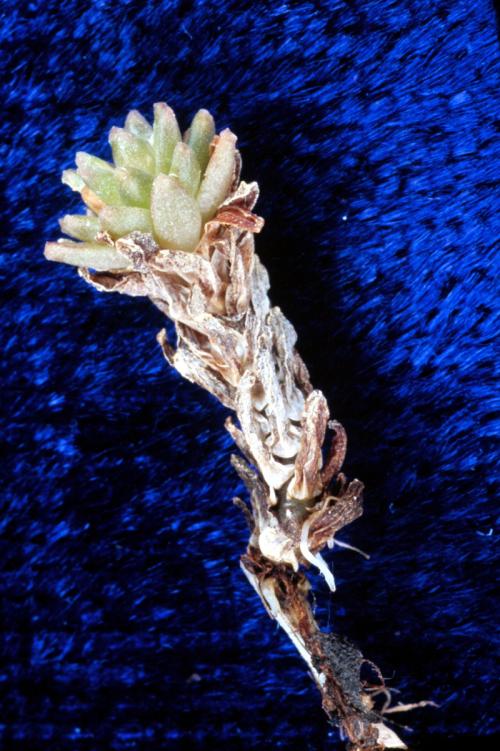LIEBMANNIANUM Hemsley, 1878
Synonym : Sedum marcescens Rose (s.a.)
Distribution : Southern USA (Western Texas) to south-eastern Mexico (Oaxaca, Puebla) ; ± 2500 m.
Description (by 't Hart & Bleij in IHSP, 2003) :
Perennial herbs or subshrubs with procumbent creeping spreading stems, with ascending or erect branches to 15 cm.
Leaves imbricate to subimbricate, alternate, suboblong to ovate, obtuse, broad at the base, shortly spurred, smooth or papillose, 4 - 6 mm.
Inflorescences : Flowering branches erect, inflorescences small cymes.
FIowers 5-merous, sessile or subsessile, sepals basally free, long spurred, slightly unequal, linear or lanceolate, obtuse, fleshy, 3 - 5 mm, erect to suberect, petals basally free, suboblong, obtuse, shortly mucronate, white, 5 - 6,5 mm, spreading, anthers red or purplish.
Cytology : 2n = ± 36 - 50, + 40, ± 50, 68, 68 - 72
Note :
‘t Hart in IHSP lists S. havardii as a synonym of S. liebmannianum. This does not seem to be correct. Charles Uhl who knew both species well considers S. havardii a species not close to S. liebmannianum (Rhodora 74, 1972 and Rhodora 87, 1985).
Ray Stephenson (Sedum, Cultivated Stonecrops, 1994, p 253) :
Similar in appearance and closely related to Sedum moranense, S. liebmannianum is much less frequently encountered in cultivation. Stems 7 cm (3 in) long have their lower sections covered with a shaggy tangle of white, dead leaves. Stems creep, then rise, and eventually can be twice this length. They dry in summer, become very brittle, and often the whole plant disintegrates, producing propagules which fall and root. Gray-green leaves, which are imbricate at first, have spurs and tinge with pink in full sun. White flowers are produced in compact clusters in summer.
Habitat : This species grows over a large range from Oaxaca to Puebla on calcareous rocks at about 2500 m (8200 ft), but is also reported from San Luis Potosí and the Chisos Mountains in western Texas.
Main points of distinction : Kyphocarpic flowers immediately separate this stonecrop from Sedum alamosamum and S. mellitulum, but not from S. diffusum, S. potosinum [see S. diffusum] or S. moranense. Sedum diffusum, including S. potosinum, has leaves with the upper face distinctly convex and the cross section almost terete, while S. liebmannianum has leaves with the upper face flat or even slightly concave and the section much flatter. Sedum moranense is a more upright plant that does not disintegrate in early winter, nor does it have lower stems shaggy with white, dead leaves. Sedum liebmannianum has long, narrow, slightly unequal, free, spurred sepals. Petals are white and mucronate. Stamens are almost as long as petals, and anthers are pale yellow.
Variation : Leaves can be smooth or papillose. Uhl (1985) showed that odd levels of ploidy exist. Many collections have a large range of elements, which are very irregular at meiosis, but n = 34 is commonly encountered. I have only grown one clone of Sedum liebmannianum, but it is reasonable to assume that variation exists in cultivation.
Horticulture : This species is as pretty as its near relatives and is very easy to grow and propagate in a greenhouse. Its biggest failing is that it is never very compact. Do not worry about plants disintegrating completely in winter. Keep them perfectly dry during this period: when watered again in spring, rapid growth quickly follows.
